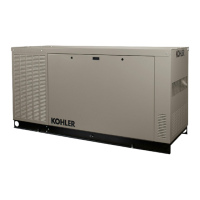TP-6811 7/1676 Section 6 Component Testing and Adjustment
6.2.1 Low to No Voltage Operation
This section covers the operation of the alternator
excitation and troubleshooting information for low or no
voltage output. Before beginning the test procedures,
read all safety precautions at the beginning of this
manual. Many of the test procedures include additional
safety precautions.
The spinning exciter and exciter board make
measurement of the field voltage and current difficult
while the generator is running. However, the alternator
and rotating exciter board can be analyzed relatively
accurately while the generator is not running. For
advanced troubleshooting procedures for the alternator,
please refer to the alternator service manual. See the
List of Related Materials in the Introduction to this
manual for document numbers.
Before beginning the troubleshooting steps in this
section, verify that the controller is trying to excite the
field on the generator. This can be determined by
observing that the generator set is in one of the following
states:
D Running
D Unloaded full speed exercise
D Unloaded cycle diagnostic mode (only during the 3
minute full speed portion of the test)
If the generator state is in one of the following states, the
controller is deliberately not exciting the alternator field
and no voltage is produced:
D Cooldown
D Unloaded cycle diagnostic mode (except during
the 3 minute full speed portion of the test)
To further isolate the cause of low or no output voltage:
1. Verify that the generator frequency is above the
cut-in frequency for the volts/Hz curve. See
Section 6.5.3.
2. Verify that the RDC2 controller is configured to
output the correct voltage and that it is metering
accurately. Check the system voltage setting and
the voltage calibration.
3. Open the line circuit breaker to see if the voltage
recovers (the generator may be feeding a short
circuit).
4. To isolate a controller/voltage regulator problem
from an internal alternator problem, perform the
alternator manual excitation procedure described
in Section 6.2.4.
5. If the alternator is able to produce greater than
rated voltage while manually excited, the problem
most likely lies in the stationary portion of the
alternator excitation control system. If not, proceed
with advanced troubleshooting of the alternator.
See the alternator service manual. See the List of
Related Materials in the Introduction to this manual
for document numbers.
6. Check the wiring from the controller to the
stationary LED board (SLB) on the back of the
alternator.
7. Start the generator set and measure the DC
voltage between P4--2 (+) and P4--1 (--) on the
RDC2 controller while P4 is connected. If this
voltage exceeds 3 VDC, remove the end cover and
measure the voltage between 3B (+) and 5B (--) at
the SLB with the SLB connected. If this is greater
than 3 VDC and the generator does not output any
voltage with the SLB in the correct position and the
line circuit breaker open, the SLB may not be
working correctly.
8. With the generator set running, disconnect P4 from
the RDC2 controller and measure the voltage
between pins P4--2 (+) and P4--1 (--). If this voltage
is greater than 3 VDC, connect an ammeter
between pins P4--2 (+) and P4--1 (--) and measure
the current that the RDC2 controller can provide. If
the current is greater than 50 mA, check the wiring
between the RDC2 and the SLB for short circuits or
damaged wiring.
9. Reconnect P4 to the RDC2 controller. Disconnect
the plug from the SLB and measure the voltage
between wire 3B (+) and 5B (--). If this voltage is
greater than 3 VDC, connect an ammeter between
wire 3B (+) and 5B (--) and measure the current that
the RDC2 controller can provide. If this is greater
than 50 mA and the generator does not output any
voltage with the SLB connected and in the correct
position and the line circuit breaker open, the SLB
may not be working correctly.
10. If the RDC2 controller is not able to source greater
than 3 VDC when P4 is disconnected or is not able
to source greater than 50 mA to an ammeter, and
the generator is shutting down on undervoltage
after starting (indicating that the controller is trying
to excite the field), it is possible that the RDC2
controller is damaged. Investigate the wiring from
the controller to the SLB and check the SLB
carefully to determine the cause of the controller
failure.

